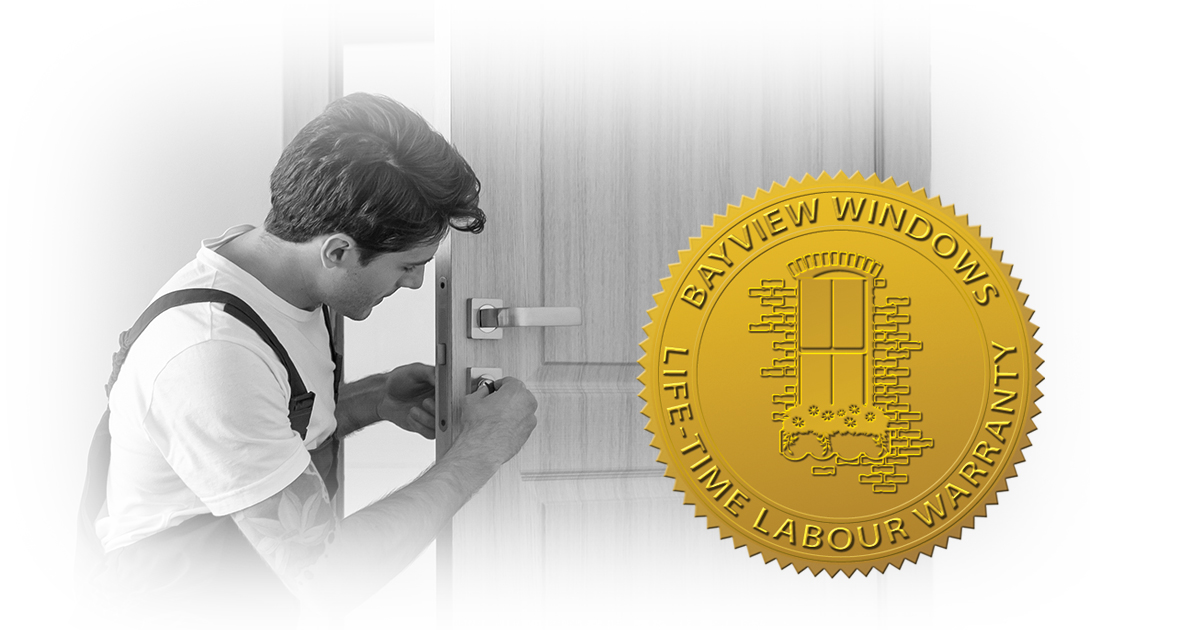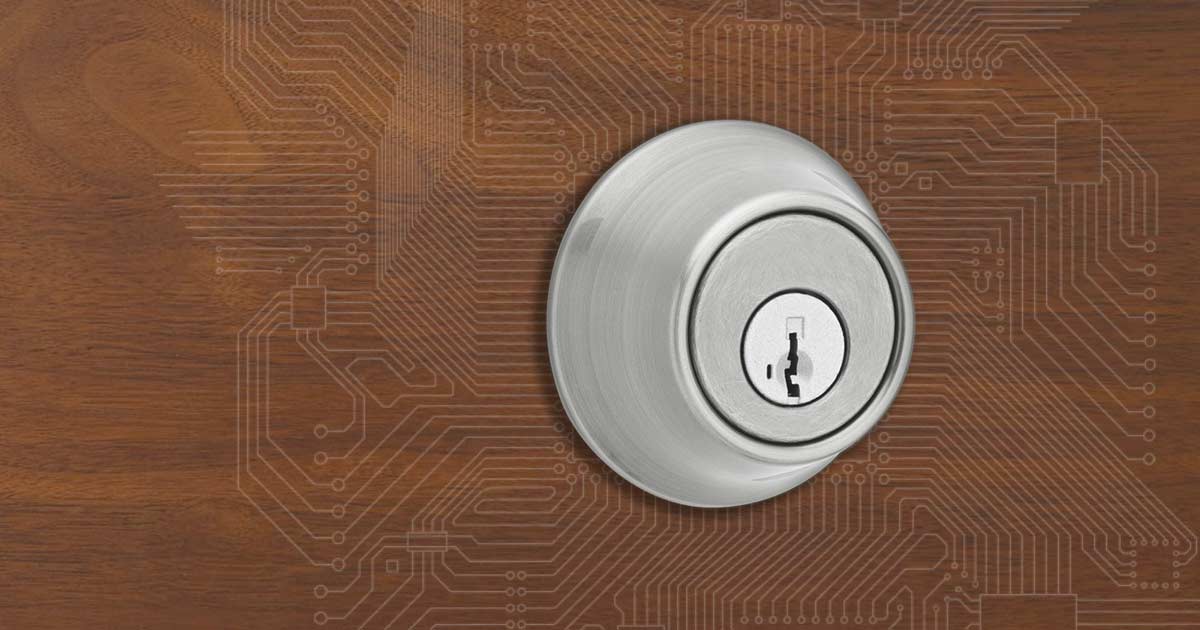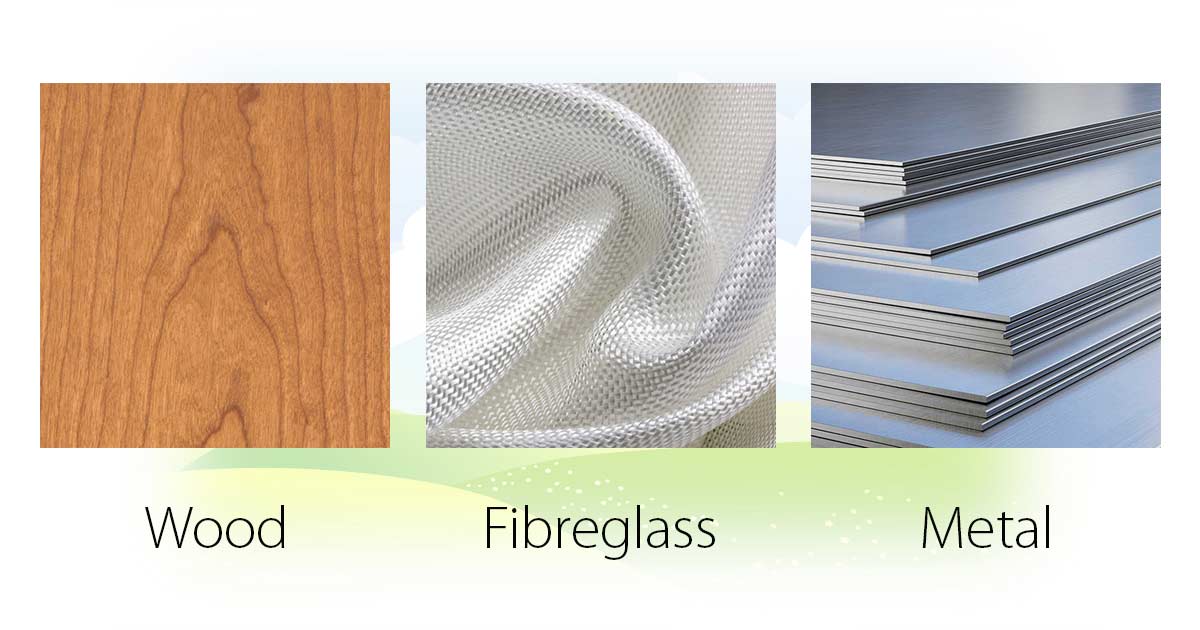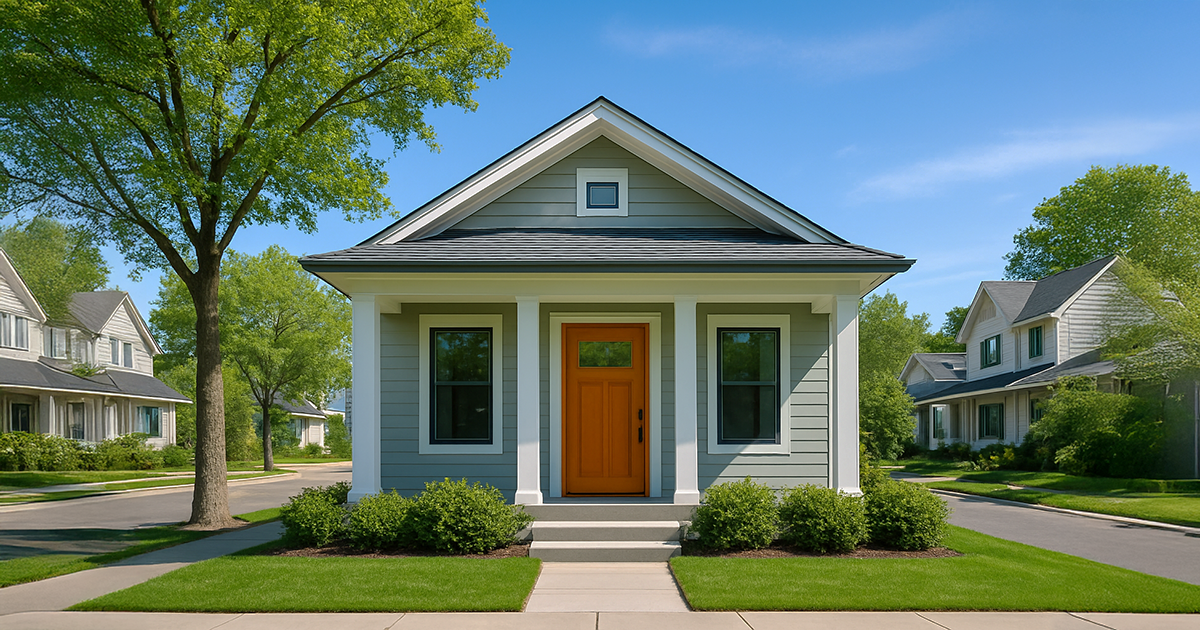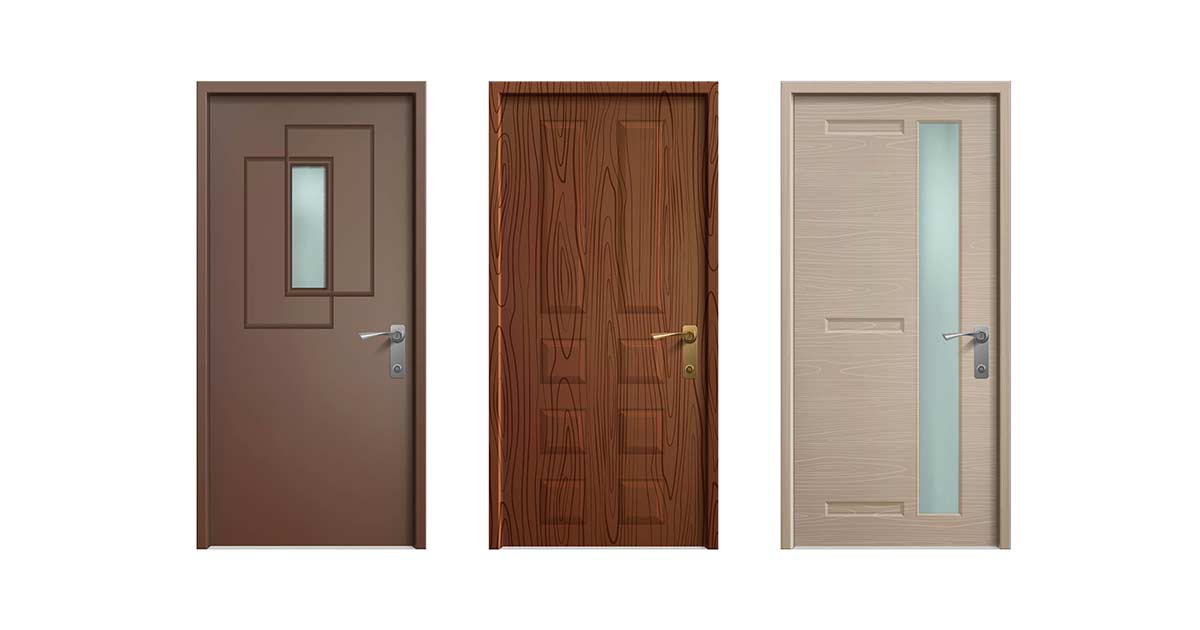Insights > Article > Posted: 2025-Mar-21, Updated: 2025-Oct-03
Making Colour Choices: What it Could Mean for Your Home's Personality & Curb Appeal
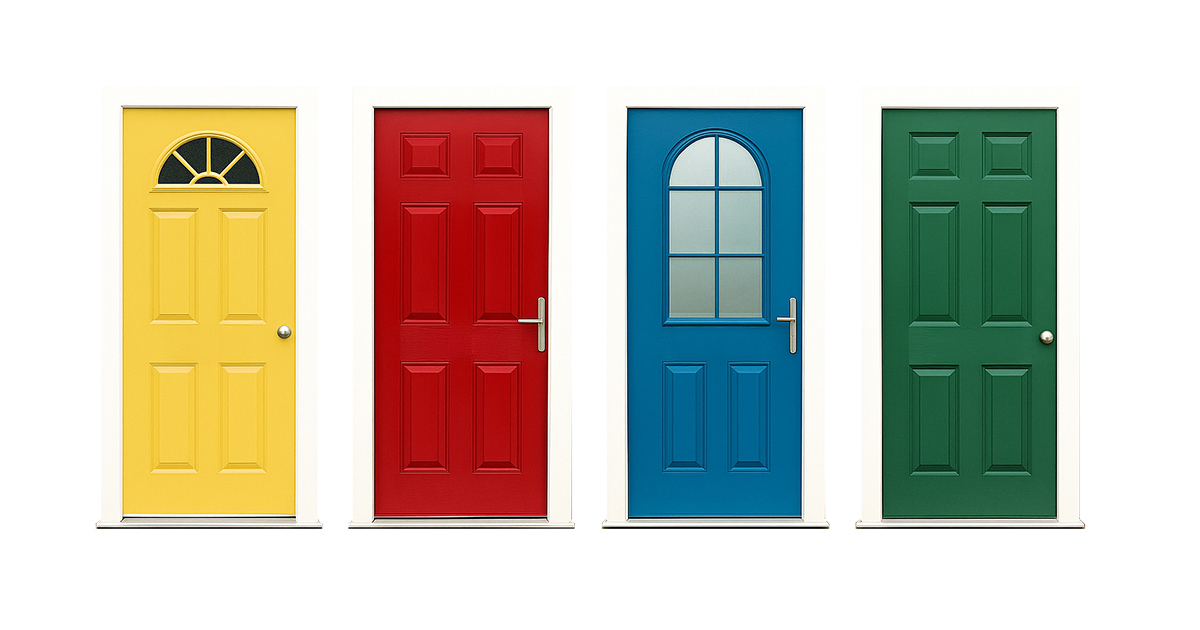
In this article:
Different colours have different meanings to different people - Colour evokes emotional feelings and affects mood, which will vary across cultures and personal preferences. Because an entry door is one of the first things you, your neighbours, your guests, and potential buyers see when approaching a home, choosing the right colour should be one of the most important door design decisions.
This article will guide you through the many colour choices and help you choose a colour that matches your personality and home. Learn how to choose a front door colour that stands out, but will not make people cringe when they see it.
Choose a colour
What can the right door colour do for a homeowner?
- It can set a mood and tone (for both owner and guests)
- It can express the occupant's personality
- It can make a home look more unique (set it apart from all the other homes)
- It can help a home blend into the neighbourhood
- It can improve curb appeal
- It can help sell your home
The Psychology of colour

The broad reach of colour psychology
Today, the captivating field of colour psychology finds its primary application in the realm of marketing and advertising. However, the intriguing insights derived from these studies extend far beyond mere commercial purposes, permeating various aspects of our lives. From the selection of clothing hues to the shades we choose for our cars and homes, the impact of colour psychology is undeniably profound.
Colour, emotion, and cultural influence
The allure of colour is intimately intertwined with our individual feelings, deeply rooted in personal experiences and cultural influences. While the perception of colour holds a degree of subjectivity, certain colour effects possess universal significance, transcending cultural boundaries.
Factors shaping colour preferences
The reasons behind people's preference for specific colours are as diverse as the colours themselves, influenced by an amalgamation of factors. Our environment, personality traits, past encounters, upbringing, and even the intricate workings of our brains play a role in shaping our colour inclinations. Colours possess the extraordinary ability to evoke both negative and positive associations, but for the sake of our discussion, let's focus on the positive aspects.
Choosing door colours for home aesthetics
When contemplating the incorporation of colour into an entrance door, it is essential to look beyond the psychological and personality implications. Instead, direct your attention to how the chosen colour harmonises with the exterior aesthetic of your home, creating a visually pleasing and cohesive ensemble.
Balancing aesthetics with durability and practicality
Your entrance door sets the tone for your home, so pick a colour that balances style and practicality. Durable finishes like semi-gloss or enamel resist wear, while darker tones may need touch-ups and lighter shades more cleaning. Sunlight and environmental factors can affect longevity, so choose wisely.
Architectural style matters too: traditional homes shine with classic tones, modern designs suit bold or neutral shades, and cottages or farmhouses pair well with soft, earthy colours. Consider materials, surrounding colours, lighting, landscaping, and door size; larger doors can handle deeper tones, while smaller doors work best in lighter shades. The right choice creates a welcoming, cohesive, and long-lasting entrance.
What your colour choice may suggest:
Your entrance door colour says a lot about your personality and sets the tone for your home. From bold and vibrant to calm and classic, each colour reflects different traits while complementing your architecture and surroundings. Consider style, atmosphere, and practicality to create a welcoming, cohesive, and lasting first impression.
Dark blue

Choosing a dark blue door shows you value reliability, sophistication, and timeless style. You appreciate quality and have a grounded, dependable personality, creating a sense of trust and calm at your home’s entrance.
- Timeless. Reliable. Sophisticated.
- A statement of quality and style.
- Bold colour, lasting elegance.
- Elevates curb appeal instantly.
Note: Some people may feel it too formal or distant if they are looking for a warm, inviting entry.
Medium blue

A medium blue door reflects calmness, professionalism, and trustworthiness. You have a steady, thoughtful nature and like to create a serene, welcoming environment.
- Calm, serene, and welcoming.
- Inspires trust and professionalism.
- Versatile, fits any style.
- A stable choice that lasts.
Note: Might come across as cold or overly corporate in some settings.
Light blue

Light blue suggests a peaceful, creative, and open-minded personality. You enjoy calm surroundings and a sense of harmony, often valuing imagination and gentle aesthetics.
- Calm, serene, and harmonious.
- Highlights creativity and artistic flair.
- Fresh, pure, and welcoming.
- Creates a tranquil retreat for relaxation.
- Makes spaces feel larger and airier.
- Timeless elegance for any style.
- Blends beautifully with nature and surroundings.
Note: Some people may feel it's too soft or insubstantial, lacking bold impact.
Red

A red door signals confidence, passion, and boldness. You’re unafraid to stand out, and your home reflects energy, warmth, and a dynamic personality.
- Bold, vibrant, and full of energy.
- Creates a warm, inviting atmosphere.
- A striking focal point for any entrance.
- Shows confidence and a dynamic personality.
- Adds drama and excitement to the home.
- Makes your home memorable and welcoming.
Note: Some people may find it overwhelming or aggressive. Balancing it with other elements ensures the overall look remains inviting and harmonious.
Orange

Choosing orange shows you’re energetic, outgoing, and adventurous. You enjoy fun, creativity, and making a memorable impression with your home’s style.
- Bold, energetic, and full of life.
- Creates a warm, welcoming atmosphere.
- Showcases creativity and an outgoing personality.
- Uplifts moods with positivity and cheer.
- A striking focal point that draws attention.
- Reflects enthusiasm, confidence, and a zest for life.
- Perfect for homeowners who embrace fun and memorable design.
Note: Its vibrancy may not appeal to everyone and may clash with the home’s style. Be sure it works with the rest of your home.
Yellow

A yellow door reflects optimism, cheerfulness, and an uplifting spirit. You’re vibrant, positive, and like to spread joy and warmth to anyone who visits.
- Bright, cheerful, and full of energy.
- Creates a welcoming, joyful atmosphere.
- Reflects optimism and a vibrant personality.
- Visually expands spaces, making them feel airy.
- Uplifts moods and spreads positivity.
- Boosts creativity and inspiration in any space.
Note: Bright and lively, a yellow door can occasionally come across as attention-grabbing or even distracting, depending on the home’s style or location.
Green

Green suggests balance, harmony, and a connection to nature. You are nurturing, practical, and appreciate stability and renewal in your home environment.
- Fresh, balanced, and calming.
- Bring the relaxing influence of nature indoors.
- Adds a refreshing, inviting touch to the exterior.
- Reflects harmony, nurturing, and sustainability.
- Symbolises growth, prosperity, and abundance.
- Versatile, complementing any architectural style.
- Creates a stress-free, welcoming entryway.
Note: While calming and natural, green can sometimes blend with the surroundings, making the entryway feel softer or less prominent.
Black

A black door conveys power, confidence, and sophistication. You appreciate elegance and simplicity, and your home makes a bold, stylish statement.
- Powerful, sophisticated, and bold.
- Makes a strong, confident statement.
- Versatile, complements any architectural style.
- Creates an exclusive, intriguing entrance.
- Enhances curb appeal with dramatic contrast.
- Practical, durable, and evokes strength and security.
Note: Depending on the surrounding environment, a black door can feel heavy or intense, potentially giving the entryway a more formal or dramatic atmosphere than intended.
White

Choosing white reflects a love for cleanliness, calm, and classic simplicity. You value flexibility and timeless elegance while maintaining a welcoming, open atmosphere.
- Clean, serene, and timeless.
- Flexible and versatile for any style.
- Brightens spaces and creates openness.
- Enhances curb appeal with classic elegance.
- Pairs easily with accents for added interest.
Note: Depending on the climate and surroundings, a white door may require more upkeep to maintain its pristine appearance, as marks and weathering are more visible.
Purple

Purple shows creativity, individuality, and a flair for the unique. You enjoy imagination, luxury, and making a bold, distinctive statement with your home.
- Creative, luxurious, and intriguing.
- Showcases individuality and artistic flair.
- Adventurous and memorable statement.
- Adds sophistication and striking elegance.
- Evokes mystery, imagination, and wonder.
- Versatile, complements any architectural style.
Note: Depending on the home’s design and surroundings, a purple door might be seen as unconventional, attracting attention that could feel out of place or overly bold.
Brown

Brown signals warmth, groundedness, and reliability. You value comfort, stability, and a cosy, natural atmosphere that feels authentic and inviting.
- Warm, comforting, and inviting.
- Grounded, reliable, and connected to nature.
- Showcases simplicity and natural elegance.
- Creates a welcoming, cosy entrance.
- Versatile, complements rustic and modern styles.
- Reflects comfort, stability, and familiarity.
- Promotes harmony with the outdoors.
Note: Depending on the setting, brown can be perceived as safe or neutral, which might not satisfy those seeking a more eye-catching entrance.
Grey

Grey suggests calmness, balance, and understated elegance. You appreciate practicality and refined simplicity, with a subtle, modern sense of style.
- Calm, balanced, and practical.
- Modern and minimalistic design.
- Refined, polished, and professional.
- Creates a serene, welcoming entrance.
- Understated elegance and simplicity.
- Versatile, complements any architectural style.
- Timeless, sophisticated, and functional.
Note: Grey doors convey calm elegance but might come across as subdued or reserved, particularly for homeowners seeking a more distinctive statement.
Pink

A pink door reflects playfulness, joy, and expressiveness. You value creativity, charm, and a fun, lighthearted approach to life and design.
- Fun, cheerful, and full of charm.
- Showcases individuality and self-expression.
- Bold and attention-grabbing statement.
- Adds personality and playful elegance.
- Creates a welcoming, joyful atmosphere.
- Enhances curb appeal with warmth and charm.
- Reflects creativity and a love for unique design.
Note: Pink doors convey fun and personality but could appear eccentric or informal if not balanced with the surrounding architecture.
Colour variations
Even subtle variations in colour can transform your door’s personality, from light and lively to deep and dramatic.
- Darker variations reflect tradition and subtlety; lighter variations express creativity and vibrancy.
- Lighter variations feel airy and open; darker variations add depth and drama.
- Each colour variation carries cultural and personal meaning, with preferences shaped by individual taste and cultural influence.
- Understanding colour psychology enhances curb appeal and welcoming vibes.
How does colour work with doors?
If we move beyond psychology and look at how a door interacts with the rest of a house, we find that many of the potentially negative colour connotations disappear. And although some people may have cultural preferences or cautions. Most colours have a positive influence on the desired perception and personality of a home.
What colour is right for you?
While colour psychology offers valuable insights, the illustration below provides a clear and practical guide for choosing door colours.
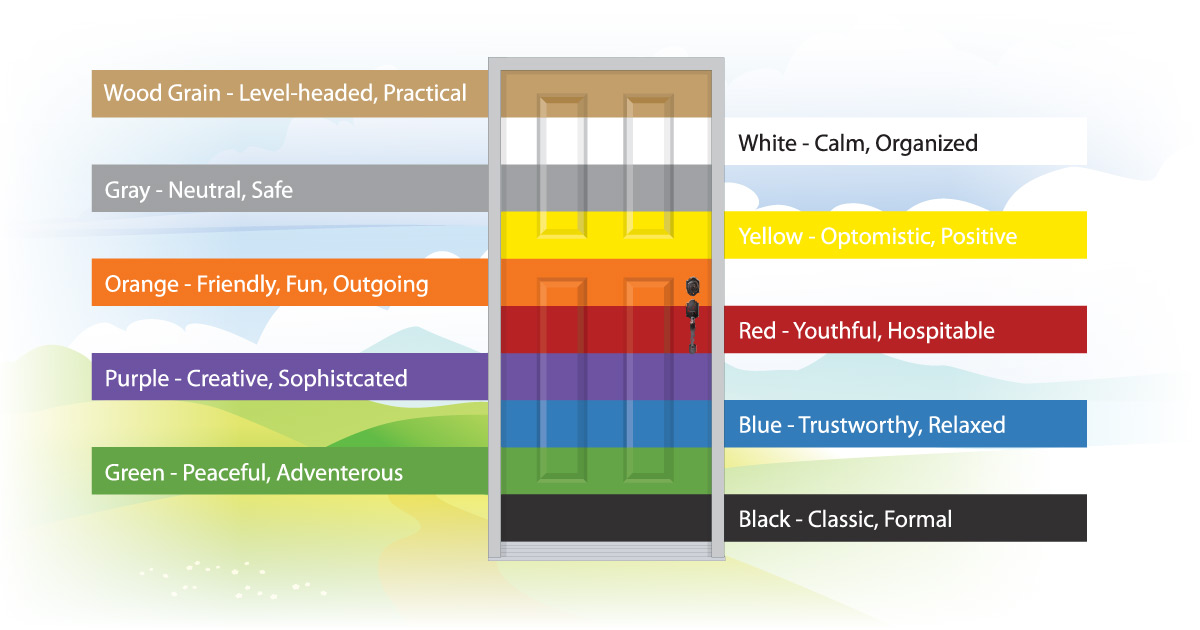
Make your door a statement
Choosing the colour of your front entrance door isn’t just about looks; it’s a bold reflection of who you are and the vibe you want your home to radiate.
Your door is one of the first things guests notice, so picking a hue that reflects your personality while harmonising with your home’s style can instantly boost curb appeal and leave a lasting impression.
Dive into the world of colour, trust your instincts, and let your front door tell your story, a splash of personality that’s as welcoming as it is unforgettable.
Summary
Although colour associations can be helpful when narrowing down choices, it’s important to recognise that they are general guidelines rather than strict rules.
The impression a door colour creates often depends on factors such as the architectural style of the home, the surrounding neighbourhood, and even cultural perspectives.
In addition, practical considerations like paint type, finish, and exposure to sunlight or weather conditions will influence both appearance and durability.
For best results, treat colour psychology as a starting point and evaluate how your preferred shades look in the specific context of your home.
Related articles
Need more information?
If you would like to know more about the colours available for our entry door products, please give us a call or request more information via our contact form. We’d be happy to answer all of your questions.
Considerations
Window into a Door
